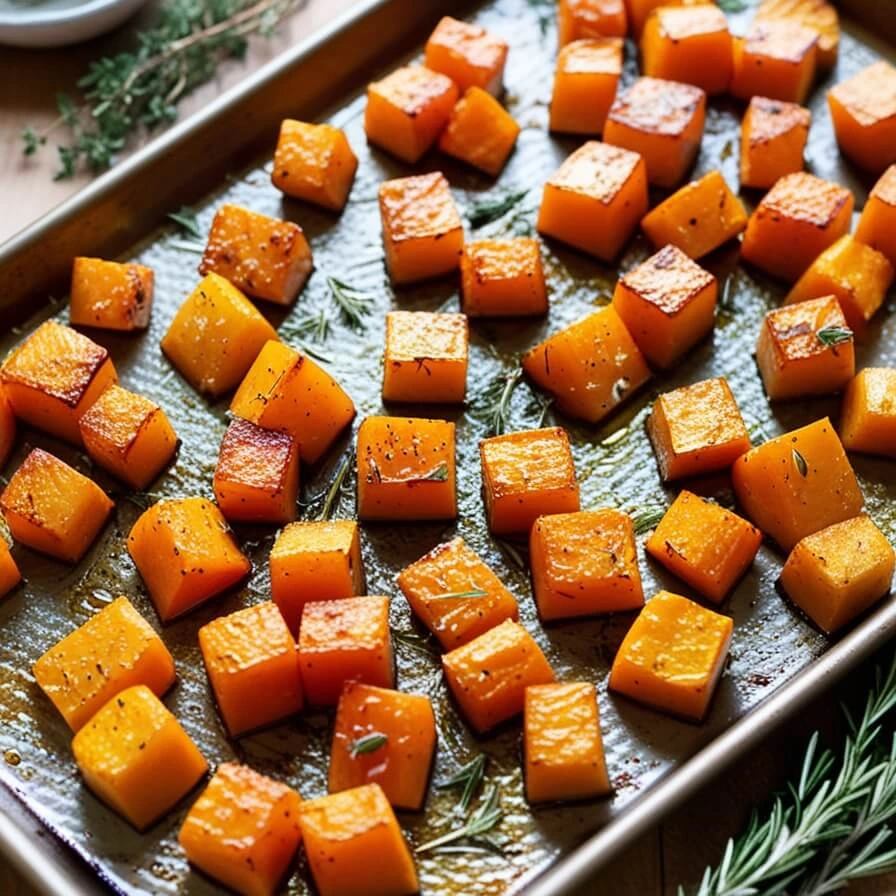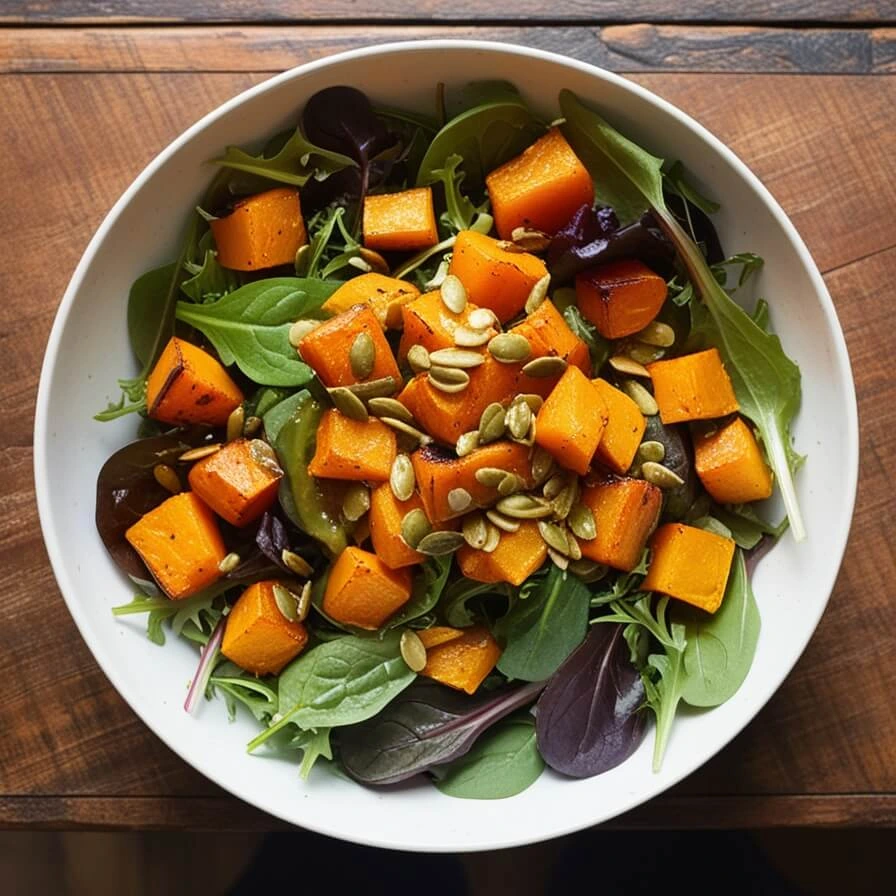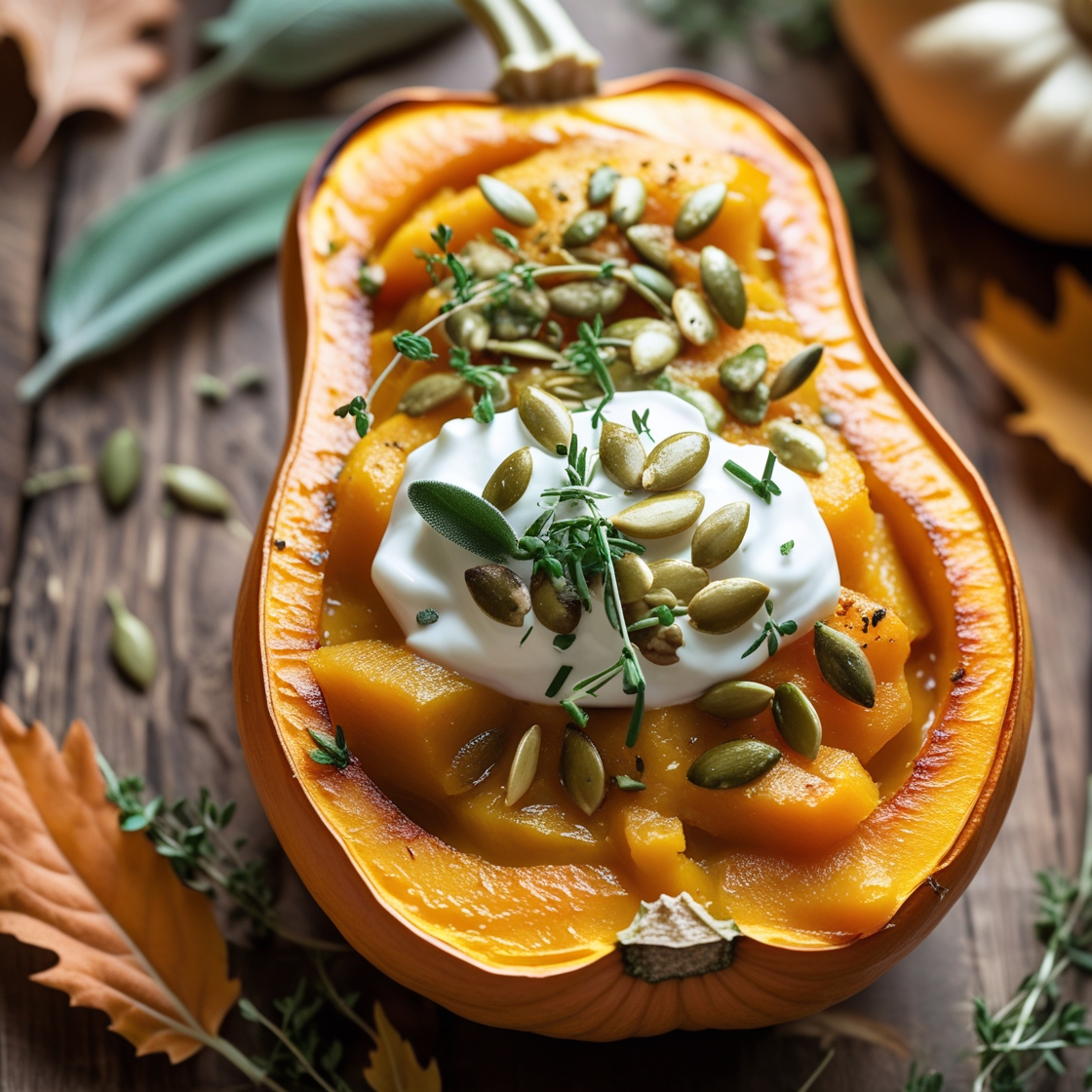Introduction
Butternut squash is the ultimate comfort food—sweet, nutty, and nutrient-packed. Whether you’re a beginner or a seasoned cook, a creamy butternut squash recipe is sure to impress. With minimal prep and just a few wholesome ingredients, this dish offers a rich, velvety texture that’s both indulgent and nutritious, loaded with vitamins A and C, fiber, and antioxidants.
Perfect for chilly evenings, fall gatherings, or a quick dinner, this versatile recipe will become a staple in your kitchen. Let’s dive into the comforting world of butternut squash!
Want a refreshing side to pair with it? Check out my Greek Salad recipe for a light, flavorful complement.
Why Everyone Loves This Creamy Butternut Squash Recipe
A Comforting Butternut Squash Dish
Nothing compares to the cozy satisfaction of a comforting butternut squash dish. The creamy texture and rich, nutty flavor make it the perfect choice for any meal. Whether you’re enjoying it as a warm soup or a luscious side dish, it’s a recipe that feels like a hug in a bowl.

The smooth, velvety consistency of this butternut squash recipe is what sets it apart. Roasting the squash brings out its natural sweetness, which blends beautifully with aromatic ingredients like garlic and onion. The result is a dish that’s not only flavorful but also indulgently creamy, making it a family favorite.
This comforting butternut squash dish is incredibly versatile. Serve it during the fall and winter months when you crave something warm and satisfying. It’s also a fantastic addition to holiday dinners, offering a unique yet familiar flavor to complement any spread.
What makes this butternut squash recipe so appealing is its ability to suit any occasion. It works perfectly as a simple weeknight dinner or as an impressive starter for guests. No matter when you make it, its rich, creamy taste and inviting aroma are sure to make it a hit.
In every spoonful of this butternut squash dish, you’ll experience the perfect balance of sweet and savory flavors. This recipe is comfort food at its finest, delivering a heartwarming meal with minimal effort. Whether you’re cooking for yourself or a crowd, this dish never fails to impress.

Health Benefits of Butternut Squash
Butternut squash is a nutritional powerhouse and a delicious addition to any diet. Packed with vitamins, fiber, and antioxidants, it offers a variety of health benefits in every bite. Whether you’re aiming to boost immunity, improve digestion, or enhance overall wellness, butternut squash delivers.
Rich in Essential Vitamins
One of its standout qualities is the abundance of vitamin A, which is vital for eye health and a strong immune system. Just one serving provides more than the recommended daily intake, helping to protect your vision and strengthen your body’s defenses. Butternut squash is also rich in vitamin C, which aids collagen production, improves iron absorption, and enhances immunity.
High in Dietary Fiber
With its natural sweetness and smooth texture, butternut squash is an excellent source of dietary fiber. This nutrient promotes better digestion and supports gut health, making it an ideal choice for those focused on maintaining a healthy digestive system.
Loaded with Antioxidants
This versatile vegetable is packed with antioxidants, including beta-carotene, which helps reduce inflammation and protects cells from damage. These powerful compounds lower the risk of chronic illnesses, such as heart disease and certain types of cancer.
A Delicious Path to Wellness
Incorporating butternut squash into your meals is a flavorful way to safeguard your health. Whether you’re eating cleaner, boosting immunity, or adding more nutritious options to your diet, butternut squash is a fantastic choice.
Enjoy these benefits with a creamy butternut squash recipe that’s both comforting and healthy. This dish combines rich flavor with exceptional nutrition, making it a win for both your taste buds and your body.
Versatile Butternut Squash Recipe Ideas
Few ingredients are as versatile as butternut squash. Its naturally sweet and nutty flavor, paired with a creamy texture, makes it an excellent base for various dishes. From hearty soups to flavorful side dishes and rich pasta sauces, the possibilities are endless.
A Warm and Comforting Soup
One popular way to enjoy butternut squash is in a warm, velvety soup. By blending roasted squash with vegetable stock, cream, or a dairy-free alternative, you can create a dish perfect for chilly evenings. To elevate the flavor, add spices like nutmeg or cinnamon. Finish it off with roasted seeds or croutons for a delightful crunch.
Savory Side Dishes
For those who prefer a savory twist, butternut squash works wonderfully as a side dish. Roast cubes of squash with olive oil, salt, and pepper for a simple yet delicious option. To take it up a notch, toss the roasted squash with feta cheese, fresh herbs, or a drizzle of balsamic glaze. Whether for casual dinners or festive gatherings, this dish never disappoints.
A Delicious Pasta Sauce
Butternut squash also shines as a pasta sauce. Blend roasted squash with garlic, cream, and Parmesan for a luscious, creamy sauce that pairs beautifully with fettuccine or ravioli. For a vegan version, swap the cream with coconut milk and use nutritional yeast instead of cheese. The result is a plant-based sauce that’s just as indulgent.
Adaptable for Every Lifestyle
This recipe is highly adaptable to various dietary needs. Whether you’re cooking vegan, gluten-free, or dairy-free, butternut squash fits seamlessly into any lifestyle. Its mild flavor and creamy texture allow for substitutions without compromising on taste or quality.
No matter how you prepare it, this versatile butternut squash recipe is a must-have in your kitchen. It’s a crowd-pleasing dish that’s sure to impress every time.
Step-by-Step Guide to Making This Butternut Squash Recipe
Preparing Butternut Squash for Roasting
Preparing butternut squash for roasting might seem like a challenge at first, but with a few simple steps, you’ll unlock its full flavor potential. The process of peeling, seeding, and chopping the squash is crucial for achieving that perfectly roasted texture and caramelized sweetness. Here’s how to do it right, along with some helpful tips to enhance the flavor of your creamy butternut squash dish.
Peeling the Squash:
Start by cutting off both ends of the butternut squash. This will create a stable base and make it easier to peel. Using a sharp vegetable peeler, remove the skin in long strips. The skin of the squash can be tough, so be sure to apply firm, even pressure as you work your way around. If you find the squash too slippery, you can also use a small paring knife to peel it. The flesh underneath is smooth and orange, perfect for roasting.
Seeding the Squash:
Once peeled, slice the squash in half lengthwise. You’ll notice that the inside is filled with seeds, much like a pumpkin. Using a spoon, scrape out the seeds and stringy fibers. This step is essential, as removing the seeds ensures that the squash roasts evenly and achieves that desired creamy consistency. You can save the seeds to roast separately for a crunchy garnish, if desired.
Chopping the Squash:
After seeding, cut the squash into uniform cubes or slices. For roasting, cubes are often the best option as they allow the squash to cook evenly and caramelize beautifully. Aim for about 1-inch cubes for optimal roasting. The smaller the pieces, the faster they’ll cook, and the more surface area you’ll get for that golden, crispy exterior. If you prefer a different texture, you can also slice the squash into rings or wedges.
Enhancing the Flavor:
Once your butternut squash is prepped, it’s time to enhance its natural sweetness and flavor. Drizzle the squash cubes with a generous amount of olive oil to help them roast evenly and get that beautiful golden color. The oil will also add richness and help the seasoning adhere. Next, sprinkle the squash with salt and freshly ground black pepper. These simple seasonings are key to bringing out the natural sweetness of the squash while balancing its flavors.
For added depth, feel free to toss the squash with a pinch of cinnamon or nutmeg for a hint of warmth, or a little garlic powder for a savory twist. Fresh herbs, such as thyme or rosemary, can be tossed in for extra flavor. If you prefer a slightly sweet finish, a drizzle of honey or maple syrup can caramelize the squash, adding a subtle sweetness that pairs wonderfully with the savory elements.
Once seasoned, spread the squash in a single layer on a baking sheet, ensuring that the pieces are not crowded. This allows them to roast evenly and develop that perfect crispy exterior. Roast in a preheated oven at 400°F (200°C) for 25–30 minutes, or until the squash is tender and lightly caramelized, flipping halfway through for even cooking.
Properly preparing your butternut squash for roasting will set the stage for a deliciously creamy dish. With a little care and attention to detail, you’ll have a flavorful, roasted squash ready to be turned into the ultimate creamy butternut squash recipe.
Blending for a Creamy Butternut Squash Puree
Once your butternut squash is roasted to perfection, the next step is blending it into a silky, smooth puree. This process is key to achieving the creamy texture that makes your butternut squash recipe so indulgent and comforting. Whether you’re using dairy or plant-based alternatives, blending the squash properly ensures that the final dish is velvety and satisfying. Here’s how to create the perfect creamy butternut squash puree every time.

Choosing Your Liquid for Blending:
Start by selecting a liquid to blend the roasted squash. Heavy cream is a traditional choice, adding richness and depth to the flavor. For a lighter, yet equally creamy texture, you can opt for half-and-half or milk. If you prefer a dairy-free version, there are many great alternatives that work wonderfully in butternut squash recipes. Coconut milk is a popular choice for a rich, slightly sweet flavor, while almond milk or cashew milk provides a more neutral, creamy base. Be sure to choose an unsweetened version to avoid overpowering the natural flavor of the squash.
Blending the Squash:
Once your roasted butternut squash is soft and tender, place it into a high-speed blender or food processor. Add your chosen liquid gradually, a little at a time, until you reach the desired consistency. The amount of liquid needed will depend on how creamy or thick you prefer your puree. Start with about 1/2 cup of liquid for every 2 cups of squash and adjust as needed.
For the smoothest texture, make sure the squash is fully roasted, soft, and tender before blending. This ensures that the puree will be free of any lumps or graininess. Blend on high for about 1-2 minutes, stopping occasionally to scrape down the sides of the blender for even blending. If you prefer an even smoother texture, you can pass the puree through a fine mesh sieve or use an immersion blender for more control.
Achieving a Silky, Smooth Texture:
To get that ultra-creamy texture, avoid overloading the blender with too much squash at once. Blend in batches if necessary, adding a little liquid with each batch to keep the puree smooth and flowing. If you find the puree too thick, add more liquid a tablespoon at a time until you reach your desired consistency. For a luxurious, silky-smooth texture, consider adding a spoonful of butter (or vegan butter) after blending for extra richness.
Flavor Enhancements:
While blending, it’s also a great time to add additional flavor enhancers. A pinch of salt and freshly ground black pepper will elevate the natural sweetness of the squash. You can also stir in a dash of ground nutmeg or cinnamon for warmth and depth. For a savory touch, a spoonful of garlic or a squeeze of lemon juice can brighten the flavor. If you want a bit of complexity, try adding a teaspoon of apple cider vinegar to balance the sweetness.
Making It Extra Creamy:
For an even more luxurious and creamy texture, consider blending in a small amount of cream cheese, sour cream, or Greek yogurt. These ingredients add richness and creaminess, giving the puree a velvety mouthfeel. Alternatively, you can use cashews to add richness, making it a great option for vegan recipes. Soaked cashews blend beautifully and provide a creamy consistency that’s hard to beat.
By following these steps, you’ll achieve a perfectly smooth and creamy butternut squash puree that will be the star of your dish. Whether you’re making soup, pasta sauce, or a side dish, this step is essential for transforming roasted squash into a velvety, comforting creation.
Adding Flavor to Your Butternut Squash Dish
The beauty of butternut squash lies in its naturally sweet and nutty flavor, but adding a few carefully chosen ingredients can elevate your dish to a whole new level. Whether you’re making a creamy soup, a savory side dish, or a pasta sauce, flavoring your butternut squash with ingredients like garlic, onion, and nutmeg will enhance its depth and complexity. Here’s how to bring out the best in your creamy butternut squash recipe with a few simple additions and garnishes.
Essential Flavor Enhancers:
Start by sautéing garlic and onion as a base for your butternut squash dish. The sweetness of the onion caramelizes beautifully when cooked, complementing the squash’s natural flavors, while garlic adds a savory depth. For extra richness, you can cook the garlic and onion in a little olive oil or butter until they’re soft and fragrant, then add your roasted squash to the mix.
Nutmeg and Cinnamon:
Butternut squash has a natural affinity for warm spices, which is why nutmeg is often included in many recipes. A small pinch of ground nutmeg adds a subtle, earthy sweetness that pairs wonderfully with the squash’s flavor. Cinnamon is another fantastic spice that enhances the natural sweetness of butternut squash, adding warmth and complexity to your dish. A tiny dash goes a long way in creating a rich, comforting taste. Both spices work particularly well in soups or when making a creamy puree.
Vegetable Stock:
To bring everything together, adding a flavorful liquid like vegetable stock can take your butternut squash dish to the next level. Whether you’re making soup or a sauce, vegetable stock provides a savory backdrop that helps balance the sweetness of the squash. It’s a great way to enhance the overall flavor profile without overpowering the dish. Opt for low-sodium stock to keep the flavor clean and fresh, or use a homemade version for even more depth.
Toppings and Garnishes:
The right toppings can turn a simple butternut squash dish into an extraordinary meal. Croutons are a great option if you’re serving the squash as a soup or a side dish. They add a delightful crunch and texture contrast that complements the creamy squash. You can easily make your own croutons by toasting cubes of bread with olive oil, garlic, and herbs.
Pumpkin seeds (or pepitas) are another perfect garnish. They bring a nutty crunch and an extra layer of flavor that pairs beautifully with the creamy squash. Simply toast the seeds with a little olive oil and seasoning for added depth. If you’re looking to add some fresh greenery, a sprinkle of fresh herbs like rosemary, sage, or thyme can give your dish an aromatic finish. These herbs are particularly well-suited to roasted butternut squash and add an earthy note that complements its natural flavor.
For a slightly sweet finish, a drizzle of maple syrup or a sprinkle of brown sugar can enhance the squash’s sweetness, making it an irresistible treat. A few shaved pieces of Parmesan cheese or a dollop of sour cream can also add richness and complexity, balancing out the flavors perfectly.
By thoughtfully adding these ingredients and garnishes, you’ll bring out the very best in your creamy butternut squash recipe, turning it into a comforting and flavorful dish that everyone will love. Whether you’re cooking for a cozy night in or preparing for a special occasion, these flavor-enhancing additions will help create a memorable meal.
How to Serve and Store Your Creamy Butternut Squash Recipe
Creative Ways to Serve Butternut Squash
Butternut squash is incredibly versatile and can be served in a variety of creative ways, transforming it into the star of any meal. Whether you’re preparing a cozy soup, a creamy sauce, or a festive holiday side dish, there are endless possibilities for enjoying this rich and flavorful vegetable. Here are some creative ideas for serving butternut squash in your meals.
Serving as Soup:
One of the most popular and comforting ways to serve butternut squash is as a warm, creamy soup. The natural sweetness of the squash, combined with its velvety texture after blending, makes it the perfect base for a hearty, satisfying soup. Simply blend roasted butternut squash with vegetable stock, cream (or a dairy-free alternative), and seasonings like garlic, onion, and nutmeg for a soothing dish. For extra flavor, top with crispy croutons, a swirl of sour cream, or a sprinkle of pumpkin seeds. This soup is perfect for chilly evenings or as a starter for a festive meal.
Butternut Squash Sauce:
For a deliciously creamy and savory pasta sauce, butternut squash can be blended with garlic, onions, and vegetable stock to create a smooth sauce. Toss this rich sauce with your favorite pasta for a comforting meal. You can also add herbs like sage or rosemary for added depth and flavor. If you want to make it extra indulgent, a bit of Parmesan cheese or a spoonful of cream cheese can help to thicken and enrich the sauce. Butternut squash pasta sauce is an excellent choice for both weeknight dinners and special occasions, offering a unique twist on classic pasta dishes.
Holiday Side Dish:
Butternut squash makes an exceptional side dish, especially during the fall and winter months. Roasting the squash with olive oil, salt, pepper, and a touch of maple syrup or brown sugar gives it a caramelized exterior and sweet interior. It pairs wonderfully with roasted meats like turkey, chicken, or pork, making it an ideal addition to your holiday dinner spread. For a more sophisticated touch, toss roasted butternut squash cubes with fresh herbs, feta cheese, and pomegranate seeds for a visually stunning and flavorful side dish. This recipe will surely impress guests at your holiday table.
Pairing with Crusty Bread:
Another creative way to enjoy butternut squash is to serve it alongside crusty bread. A warm, comforting butternut squash soup or puree is perfectly complemented by a slice of toasted sourdough, ciabatta, or whole grain bread. The bread adds a satisfying crunch that contrasts beautifully with the smooth texture of the squash. For a heartier meal, make a butternut squash sandwich by spreading the puree onto the bread and adding arugula or spinach for a fresh contrast. A simple drizzle of olive oil or a spread of garlic butter can elevate the bread’s flavor and make it even more irresistible.
Roasted Vegetables and Butternut Squash:
If you’re looking for a filling and nutrient-packed meal, pair your roasted butternut squash with an assortment of roasted vegetables. You can combine the squash with other seasonal vegetables like brussels sprouts, carrots, and sweet potatoes, roasting them with olive oil, herbs, and spices. The caramelization from the roasting process brings out the natural sweetness of the squash and vegetables, creating a perfect balance of savory and sweet. This makes for an excellent side dish to any main course or a satisfying vegetarian meal.
Fresh Salad with Butternut Squash:
Butternut squash also works wonderfully in a fresh, vibrant salad. Roasted butternut squash pairs well with leafy greens like arugula, spinach, or mixed greens. Add some goat cheese or feta for creaminess and a handful of walnuts or pumpkin seeds for crunch. A simple dressing made with olive oil, balsamic vinegar, and a touch of honey complements the sweetness of the squash. This salad is perfect as a light lunch or as a side dish to balance out heavier meals, making it an excellent choice for both casual and formal gatherings.

By exploring these creative ways to serve butternut squash, you can enjoy this versatile vegetable in a variety of delicious and satisfying forms. Whether you’re serving it as a comforting soup, a rich sauce, or as part of a fresh salad or roasted vegetable medley, butternut squash is sure to become a go-to ingredient in your kitchen.
Storing Leftover Butternut Squash Dishes
Leftover butternut squash dishes are a convenient way to enjoy a comforting meal again later, but proper storage is key to preserving both the texture and flavor. Whether you have leftover butternut squash soup, puree, or roasted squash, following the right steps will ensure that your leftovers stay fresh and delicious. Here’s how to store, refrigerate, and freeze your leftover butternut squash dishes, along with tips on reheating to maintain their original appeal.
Refrigerating Leftover Butternut Squash Dishes:
If you plan to eat your leftovers within a few days, refrigerating them is the best option. First, allow the butternut squash dish to cool down to room temperature before storing. This helps prevent condensation from forming inside the container, which can lead to sogginess or mold growth. Transfer the dish into an airtight container, making sure it’s sealed tightly to preserve freshness. Roasted butternut squash can be stored in the fridge for up to 3–4 days, while soups or purees typically last 3 days.
To prevent the dish from drying out, you can cover it with a layer of plastic wrap or wax paper before sealing the container. If you’ve made a large batch of soup, you can store individual portions in smaller containers for easy reheating later. If you’re storing a puree or soup, make sure the container allows for some extra space, as liquids tend to expand slightly when cooled.
Freezing Leftover Butternut Squash Dishes:
For longer storage, freezing is an excellent option, especially if you have a large amount of leftover squash. Freezing preserves the flavor and texture of butternut squash dishes for up to 3 months. To freeze leftover butternut squash soup or puree, allow the dish to cool completely. Then, transfer it to a freezer-safe container or freezer bag. If you’re using a freezer bag, be sure to squeeze out any excess air to prevent freezer burn. For soups, freezing in single-serving portions is ideal for easy reheating.
If you’ve roasted butternut squash and have leftovers, you can also freeze the cubes. To keep them from sticking together, spread the roasted squash cubes on a baking sheet in a single layer and freeze them for about 1-2 hours. Once frozen, transfer the cubes to a freezer-safe bag or container. This method, known as flash freezing, helps maintain the shape and texture of the squash.
Reheating Leftover Butternut Squash Dishes:
When it’s time to enjoy your leftovers, reheating properly is essential to maintaining the dish’s original flavor and texture. Here are some reheating tips for different types of butternut squash dishes:
- Roasted Butternut Squash:
If you’ve stored roasted butternut squash, the best method to reheat it is in the oven. Preheat your oven to 350°F (175°C), spread the squash on a baking sheet, and cover it with foil to prevent it from drying out. Reheat for about 10-15 minutes, or until it’s heated through. If you prefer a bit of crispiness, remove the foil in the last few minutes of reheating. For a quicker option, you can reheat roasted squash in the microwave, but this may affect the texture slightly. - Butternut Squash Soup or Puree:
For reheating leftover butternut squash soup or puree, the stove is your best bet to retain the smooth and creamy consistency. Pour the soup or puree into a saucepan and warm it over medium heat, stirring occasionally. If the soup has thickened in the fridge or freezer, you can add a bit of vegetable stock or milk to reach your desired consistency. Heat until the soup is warmed through, but avoid bringing it to a boil, as this can affect the texture.If you’re reheating in the microwave, transfer the soup or puree to a microwave-safe container, cover loosely with a lid, and heat in 1-minute intervals, stirring in between, until it’s hot. This method works well for individual servings.
Additional Tips for Maintaining Texture and Flavor:
To ensure that your leftover butternut squash dishes stay as delicious as when they were first made, there are a few additional tips you can follow:
- For soups: If the soup has separated during storage, simply stir it well while reheating. If necessary, add a bit more liquid to bring it back to its original creamy consistency.
- For purees: Re-blending the puree for a few seconds after reheating can help restore its silky texture. If you find it too thick, add a splash of cream, milk, or vegetable stock to loosen it up.
- Avoid multiple reheats: Reheat only the portion you plan to eat to prevent the dish from losing quality due to repeated reheating.
By following these storage and reheating guidelines, you can enjoy your butternut squash dishes long after the first meal, maintaining their full flavor and creamy texture. Whether you’re preparing for a future meal or just enjoying leftovers, these steps will help your dishes stay as delicious as when they were first made.
Meal Prep with Butternut Squash Recipes
Butternut squash is not only a versatile and delicious ingredient, but it also makes a fantastic base for meal prep and weekly meal planning. With its naturally sweet, nutty flavor and rich texture, butternut squash can be easily incorporated into a variety of dishes, making it a time-saving and nutritious component for busy weeks. Whether you’re preparing soups, purees, or roasted squash, this vegetable is a great option for batch cooking, allowing you to prepare multiple meals at once and save time during the week. Here’s how to incorporate butternut squash into your meal prep strategy.
Batch Cooking with Butternut Squash Recipes:
One of the main benefits of using butternut squash in meal prep is its ability to be easily cooked in large batches. Roasting a tray of squash cubes ensures you have a base ingredient ready for several meals.
Roasting Butternut Squash
Start by peeling, seeding, and chopping the squash. Toss it in olive oil, salt, and pepper, then roast at 400°F (200°C) for about 25-30 minutes, or until golden and tender. You can make a large batch and store the cubes in the refrigerator for up to 4 days or freeze them for later use. Roasted squash can be added to a variety of dishes throughout the week, making meal prep a breeze.
Making Butternut Squash Soup
For soups and purees, roast or steam a large quantity of butternut squash, then blend it with stock, cream, or a dairy-free alternative. Portion out the soup into single-serving containers and refrigerate or freeze. Butternut squash soup holds up well in the freezer and actually tastes better after the flavors have had time to meld together. For a creamier texture, add cream cheese or coconut milk before blending. Store it in air-tight containers for easy reheating.
Weekly Meal Planning with Butternut Squash:
When planning meals for the week, roasted butternut squash cubes, purees, or soups can be incorporated into different types of dishes. For a well-rounded meal plan, keep these different ways of using prepared butternut squash in mind:
- Lunches:
Roasted butternut squash cubes are perfect for adding to salads. Pair them with leafy greens like spinach, arugula, or kale, and add protein sources like chicken, tofu, or chickpeas. You can also mix the squash with grains like quinoa, farro, or wild rice for a filling and nutritious lunch. Top with a light dressing and enjoy a quick, healthy meal. Alternatively, a hearty butternut squash soup can be packed in thermos containers for easy, portable lunches. - Dinners:
A simple butternut squash puree can be served alongside roasted meats like chicken, pork, or turkey. You can also make it the base of a delicious pasta sauce. Combine the squash puree with vegetable stock, garlic, and onion, and toss with pasta for a creamy sauce. If you prefer a vegan option, you can pair the squash with roasted vegetables like brussels sprouts, carrots, and parsnips to create a complete meal. - Snacks and Sides:
Butternut squash also makes an excellent snack or side dish. For a quick snack, try adding roasted squash cubes to a grain bowl with hummus or avocado. You can also use the squash as a side for your dinner by serving it with grilled fish or steak. If you’re preparing for the week ahead, you can even portion out small servings of roasted squash for easy side dishes that require minimal effort during busy evenings.
Pairing Prepared Butternut Squash with Other Dishes:
While butternut squash is delicious on its own, it also pairs wonderfully with many other ingredients. Here are some ideas for combining prepared squash with complementary dishes to make your meal planning more dynamic:
- Grains:
Butternut squash pairs beautifully with grains like quinoa, farro, couscous, or brown rice. You can create hearty bowls by combining roasted squash with these grains and adding proteins like chicken, lentils, or tofu. A drizzle of balsamic vinegar or a sprinkle of feta or goat cheese can elevate the dish and balance out the sweetness of the squash. - Greens and Herbs:
Pair your prepared squash with leafy greens like spinach, arugula, or kale. The freshness of these greens complements the sweetness of the squash perfectly. You can also add rosemary, sage, or thyme for an extra burst of flavor. These herbs pair wonderfully with roasted squash, especially when used in soups or roasted vegetable medleys. - Proteins:
Prepared butternut squash can be paired with a wide variety of proteins. If you’re going for a vegetarian or vegan meal, roasted squash can be combined with chickpeas, black beans, or tofu for a hearty and satisfying dish. For non-vegetarian meals, it pairs beautifully with chicken, pork, turkey, or even fish like salmon. The sweetness of the squash balances the savory flavors of the protein, creating a well-rounded dish. - Nuts and Seeds:
Adding some toasted nuts or seeds—like pumpkin seeds (pepitas), walnuts, or pecans—to a butternut squash dish adds crunch and texture. It also introduces healthy fats and protein to the meal. These make great toppings for a salad or roasted squash dish and add an extra layer of flavor.
By incorporating butternut squash into your meal prep and planning, you can create a wide variety of dishes that are both delicious and nutritious. With its versatility and ability to pair with many different ingredients, it’s easy to incorporate butternut squash into every meal, whether it’s a comforting soup for lunch, a savory side dish for dinner, or a hearty salad for a light yet satisfying snack. With a little bit of batch cooking and creativity, butternut squash can become a staple ingredient in your weekly meal rotation.
Conclusion
This creamy butternut squash recipe is a must-try for anyone looking to enjoy a comforting, nutritious, and versatile dish. With its rich texture, warm flavors, and countless ways to adapt it, it’s the perfect addition to any meal plan. Whether you’re using it as a soup, side dish, or pasta sauce, the possibilities are endless, and each bite is packed with health benefits like vitamins A and C, fiber, and antioxidants.
We encourage you to get creative and experiment with your own variations! Add your favorite herbs, spices, or toppings to make the recipe your own. Don’t hesitate to try it vegan, gluten-free, or paired with different proteins and grains. Your version of this creamy butternut squash dish could be the next crowd-pleaser at your table.
If you enjoyed this recipe, we’d love to hear from you! Share your thoughts, tips, or any unique twists you’ve made in the comments below. Don’t forget to share this post with friends or family, and try the recipe today for a deliciously satisfying meal!
Check out these additional resources to inspire your cooking:

